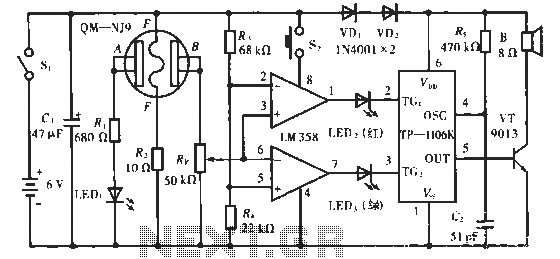
FM Receiver Circuit

There are instances when a radio station can be found, and other times when no stations are detectable. The primary issue while tuning appears to be that any movement of the hands or body, such as releasing the tuning capacitor or touching the 10k potentiometer, causes the currently tuned station to either vanish or occasionally become clearer. This necessitates maintaining an awkward position to stay tuned to the station. This phenomenon is also observed in commercially available radios. Suggestions for improving tuning reliability would be appreciated, as the forum seems inactive at the moment.
Additionally, there is a critique directed towards an individual named P. Marian for posting a circuit without having tested it, raising questions about the ethics of sharing unverified information. The commenter expresses disappointment in the lack of responsibility taken for the circuit’s functionality and urges that any untested circuits should be clearly marked as such to prevent misleading others.
The described scenario highlights issues faced in tuning FM radio circuits, particularly with the sensitivity of the tuning components. The tuning capacitor and the potentiometer play critical roles in the circuit's ability to select and maintain a station. Variations in capacitance or resistance due to external factors, such as human interference, can lead to instability in the reception quality.
In a typical FM receiver circuit, the tuning capacitor is responsible for adjusting the resonant frequency of the circuit, which is crucial for selecting the desired frequency band. The 10k potentiometer, often used as a volume control or as part of the tuning mechanism, can introduce additional variability in the circuit's performance.
For improved reliability in tuning, it may be beneficial to implement a more robust circuit design that minimizes the impact of physical interference. This can be achieved by using shielded components, ensuring proper grounding, and possibly incorporating feedback mechanisms that stabilize the tuning process.
Moreover, it is advisable to conduct thorough testing of any circuit designs before sharing them publicly. This ensures that users receive accurate information and can trust the functionality of the circuits being discussed. Proper documentation and transparency regarding the testing process can foster a more reliable and supportive community around electronic projects.Sometimes I can find a station and sometimes I can`t find any stations. Probably the main problem when tuning is, as soon as you move your hands or body, let go of the tuning cap or touch the 10k pot, whatever station you had on will either disappear or sometimes become clearer, which means you have to stand in some contorted position to remain on the station, I know this also happens with radios you can buy so any ideas what i`m doing wrong, or any tips on tuning this thing a bit more reliably I would post this in the forum but it doesn`t look too active at the moment. Dear P. Marian, I am astonished and shocked . you have posted a circuit here, which you must have picked up from some magazine or website, without even assembling and trying it out, and then you have the audacity to comment Yes, it won`t work, you are so smart!
How did you figure it out that this fm receiver circuit won`t function properly to bauxit! May I ask you how did YOU figure it out that the circuit will work, even without trying it out The circuit may or may not work, but that is not the question here it is a matter of ethics. If you post a circuit which you have not actually assembled and tried out, then you should mention this fact right in the beginning of the post.
That absolves you of all responsibilities regarding the functioning of the circuit. Many people have written here saying that they have constructed the circuit and it does`t work, instead of answering their queries you make funny remarks on others! I am sorry if I sound a bit harsh, I have no malice against you, but I would really appreciate if you post articles after actually trying them yourself.
Thanks and all the best. 🔗 External reference
Additionally, there is a critique directed towards an individual named P. Marian for posting a circuit without having tested it, raising questions about the ethics of sharing unverified information. The commenter expresses disappointment in the lack of responsibility taken for the circuit’s functionality and urges that any untested circuits should be clearly marked as such to prevent misleading others.
The described scenario highlights issues faced in tuning FM radio circuits, particularly with the sensitivity of the tuning components. The tuning capacitor and the potentiometer play critical roles in the circuit's ability to select and maintain a station. Variations in capacitance or resistance due to external factors, such as human interference, can lead to instability in the reception quality.
In a typical FM receiver circuit, the tuning capacitor is responsible for adjusting the resonant frequency of the circuit, which is crucial for selecting the desired frequency band. The 10k potentiometer, often used as a volume control or as part of the tuning mechanism, can introduce additional variability in the circuit's performance.
For improved reliability in tuning, it may be beneficial to implement a more robust circuit design that minimizes the impact of physical interference. This can be achieved by using shielded components, ensuring proper grounding, and possibly incorporating feedback mechanisms that stabilize the tuning process.
Moreover, it is advisable to conduct thorough testing of any circuit designs before sharing them publicly. This ensures that users receive accurate information and can trust the functionality of the circuits being discussed. Proper documentation and transparency regarding the testing process can foster a more reliable and supportive community around electronic projects.Sometimes I can find a station and sometimes I can`t find any stations. Probably the main problem when tuning is, as soon as you move your hands or body, let go of the tuning cap or touch the 10k pot, whatever station you had on will either disappear or sometimes become clearer, which means you have to stand in some contorted position to remain on the station, I know this also happens with radios you can buy so any ideas what i`m doing wrong, or any tips on tuning this thing a bit more reliably I would post this in the forum but it doesn`t look too active at the moment. Dear P. Marian, I am astonished and shocked . you have posted a circuit here, which you must have picked up from some magazine or website, without even assembling and trying it out, and then you have the audacity to comment Yes, it won`t work, you are so smart!
How did you figure it out that this fm receiver circuit won`t function properly to bauxit! May I ask you how did YOU figure it out that the circuit will work, even without trying it out The circuit may or may not work, but that is not the question here it is a matter of ethics. If you post a circuit which you have not actually assembled and tried out, then you should mention this fact right in the beginning of the post.
That absolves you of all responsibilities regarding the functioning of the circuit. Many people have written here saying that they have constructed the circuit and it does`t work, instead of answering their queries you make funny remarks on others! I am sorry if I sound a bit harsh, I have no malice against you, but I would really appreciate if you post articles after actually trying them yourself.
Thanks and all the best. 🔗 External reference





